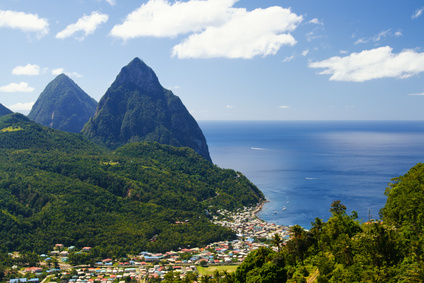HOMER Case Study: Rocky Mountain Institute
Saint Lucia, like other island nations in the Caribbean, experiences high and volatile energy prices and has an economy extremely vulnerable to fluctuations in global oil prices. When combined with heavy reliance on fossil fuel imports, the situation presents a barrier to continued socio-economic development. Natural resources offer strong potential for local generation of renewable energy. As the cost of renewable energy technologies declines, the integration of renewable energy into existing systems can benefit utilities and customers, resulting in a more resilient community. However, island governments and utilities face a host of complex issues around the development and integration of renewable energy and energy efficiency. Identifying and screening particular projects, as well as assessing portfolios of investments, requires thorough analysis.

Piton mountains in Saint Lucia
In early 2016, St. Lucia Electricity Services Limited (LUCELEC) launched plans to develop a 3 MW solar photovoltaic (PV) project to reside north of Hewanorra International Airport at La Tourney, Vieux Fort. This project is part of the nation’s plan to transition to 35% renewable energy penetration and reduce electricity consumption in the public sector by 20% by 2020. Although there are currently about 50 small solar photovoltaic (PV) systems connected to the LUCELEC grid providing about 500 kilowatts of electricity from renewable sources, the new solar farm is anticipated to provide over 5% of the island’s power generation needs. This is the first utility-scale solar project in Saint Lucia as well as the first such project facilitated by the partnership between Rocky Mountain Institute – Carbon War Room (RMI-CWR) and Clinton Climate Initiative (CCI).
Rocky Mountain Institute (RMI) is an independent nonprofit dedicated to transforming global energy use to create a clean, economically viable, and secure low-carbon future. In 2014, RMI merged with Carbon War Room (CWR), founded by Sir Richard Branson, whose business-led market interventions advance a low-carbon economy. In 2015, the RMI-CWR Smart Island Economies program joined with the Clinton Climate Initiative’s (CCI) Diesel Replacement program to form the current Islands Energy Program.
The Program works with island partners to support a cost-effective energy transition to benefit all national stakeholders. The team helps countries accelerate their renewable energy transition by guiding the planning process, de-risking projects, and by building an online Caribbean Renewable Energy Community that enables continuous knowledge exchange between island utilities.
Saint Lucia: Designing a Viable Energy Transition Strategy
In Saint Lucia, the team is working with the government and utility to design a viable energy transition strategy, determining how best to move Saint Lucia’s energy sector to meet the objectives of the National Energy Policy. The strategy includes integrating the optimum mix of renewables at the lowest cost and without compromising stability and reliability. RMI-CWR and CCI are using HOMER Energy software to assist Saint Lucia in long-term integrated resource planning, microgrid assessments, and renewable energy project screening.
“The HOMER model’s ability to test generation-level performance across multiple generation assets and through every hour of a year allows for deep and long-term planning that delivers detailed and high-level insights,” explains RMI senior associate Kaitlyn Bunker. “By testing sensitivities, users of HOMER software can explore how suggested projects perform under a variety of future conditions, allowing for nuanced exploration and planning – leading to better projects.”
“HOMER Energy is increasingly well known in the Caribbean, and recognized as a flexible and effective tool to assist with energy planning,” says Roy Torbert, Principal at RMI. “The ability to run HOMER quickly across platforms lets all stakeholders use the tool to explore results and hold informed dialogues.”
The Islands Energy Program will use HOMER software for future integrated resource planning projects with other island partners in coming months.
